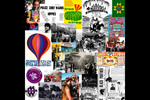The Artists Liberation Front and the Formation of the Sixties
Counterculture
The Early History of the Digger Movement
In 1976, San Francisco's underground radio station KSAN-FM broadcast a
marathon 72-hour program of interviews and music looking back at the
Summer of Love, the name that the hippies had given to the events nine
years earlier. The producers called this three-day radio program
"What Was That?", a phrase that evokes bewilderment and
astonishment on the part of the questioner about an unexpected and
unexplained experience. It is also a question that many people found
themselves asking, long even after the Sixties faded. Millions of people
participated in these events, and found their lives fundamentally and
radically changed. Some historians would argue that perspective only comes
with enough time to separate the investigation from momentous upheavals.
Nevertheless, it is for all those who are still asking "What Was
That" that we seek to understand the causes of that fateful,
tumultuous, frantic decade.
In the 1960s, the generation of Americans born in the 1940s, the
"baby boomers," came of age. To the dismay of their parents,
they turned away from traditional middle class values -- career, family
and religion -- and adopted lifestyles in open rebellion toward
established institutions. The ideas and attitudes that inspired these new
lifestyles became the soil out of which grew an American counterculture.
The outward aspects of this counterculture contrasted sharply with the
staid fashions of the previous decade. Suddenly, young people were
dressing in strange and exotic ways, adopting bright clothes, faded jeans,
denim shirts, and long hair for the men. Large gatherings of young people
became the decade's watermarks- the be-ins, rock concerts, civil-rights
demonstrations, peace marches, and sit-ins. "Drugs, Sex & Rock 'n
roll" -- this became the decade's anthem.
The inner aspects, the ideas of the counterculture, were harder to
pinpoint: the urge to personal freedom, creativity, direct action to take
control over one's life, reaction against mediocrity and conformity, the
exploration of inner spiritual realms, and above all a disaffection from
the consumer culture which America had become. The older generation mostly saw
only the outward aspects of the counterculture; they could not comprehend
why their children were behaving in bizarre and frightening ways. The
younger generation responded with an innate, intuitive understanding of
the counterculture - - while largely unaware of the genesis of these new
ideas.
The Sixties counterculture did not materialize from thin air. It grew
out of a tradition that appears throughout American and Western history,
challenging the basic assumptions of Western culture. We can trace that
tradition through avant-garde arts movements on the one hand, and through
radical political groups on the other. Rarely do such movements combine a
radical political perspective with the avant-garde, bohemian lifestyle.
The fusing of these two approaches was an important development in the
evolution of the Sixties' counterculture. Where did this transformation
take place? That hotbed of the radical, offbeat and subversive - the City
of San Francisco.
The San Francisco Bay Area had provided a fertile breeding ground where
such movements flourished, and where many threads that shaped the Sixties
counterculture first came together. This is a history of ideas that
evolved and combined and synthesized and continued evolving to become the
essential ingredients that were right for the time, to which thousands of
people, mostly young, responded innately. They took up the call, dropping
out of schools, jobs, the military. Like some Pied Piper's army, they
heard a distant call, and disappeared into a magic mountain in the clouds.
This history will attempt to delineate the evolution of ideas that
produced this siren call.
<<==>><<==>>
In 1966 a group of San Francisco artists formed an organization for
mutual support and direct action against the arts establishment. They
called themselves the Artists Liberation Front, a name that reflected
their opposition to the United States involvement in the war in South
Vietnam, where the Communist insurgents called themselves the National
Liberation Front. Rarely do artists collaborate; even more rarely do they
collaborate with a political purpose. This synthesis produced far-reaching
effects for the growing counterculture.
We can trace the tradition of avant garde, bohemian arts in the Bay
Area back to Gold Rush days; more directly, a signal impulse happened in
October, 1955, at a poetry reading in San Francisco at the Six Gallery.
Allen Ginsberg read a new poem, now-famous, "Howl." This event
signaled the beginning of a new movement, the San Francisco Poetry
Renaissance. As Tuli Kupferburg put it, "Beat poetry threw art back
into the eyes, the ears, the faces, the bodies of the people. It took type
off the page and once again reading out loud to live audiences started in
coffee shops, later expanding to college campuses, churches, parks,
etc." [ 1]
The North Beach neighborhood, which itself is the traditional home for
two of San Francisco's ethnic minorities (the Chinese and Italians),
became the center of a thriving subculture in the late 1950s. When the
world became aware of the "Beat Generation" [note ?] [a term
Jack Kerouac invented and John Clellon Holmes popularized, from which the
local San Francisco legend and writer Herb Caen coined
"beatnik."], poetry was but one of many arts thriving in the
neighborhood. Painters, sculptors, writers, photographers, dancers,
musicians, film-makers, printers, and poets made North Beach their haven.
Artists shared their lives and work in close proximity.
Inevitably, as the world took notice of this special and unique
neighborhood, the hucksters and hustlers moved in. North Beach soon gained
another reputation as the birthplace of the "topless bar." An
immediate influx of tourist traffic flooded the once-quiet neighborhood,
and the police suddenly took an interest in the poetry-loving,
pot-smoking, bearded and free-swinging denizens of the area. The natural
reaction of the beatniks was "to split the scene," and many
artists moved out of North Beach to other neighborhoods. One such area,
known as the Haight-Ashbury, bordered San Francisco's gem of civic pride,
Golden Gate Park.
<<==>><<==>>
At this time (mid-to-late 50s), a new political consciousness was also
developing, and the New Left formed out of the ashes of the Old Left. The
communist scares and witch-hunts which dominated American political life
after World War II had decimated the Old Left. This period culminated in
1953 with the executions of leftists Julius and Ethel Rosenberg, the only
civilians executed in the United States for espionage.
Like the counter-culture, there was an impulse event that signaled the
formation of a new political movement in America. The inspiration for the
rebirth of the American Left moved "from black to white." [
2] When, in 1955, the African-American seamstress Rosa Parks refused to take a
seat in the back of a Montgomery, Alabama bus, her arrest led to the
Montgomery Bus Boycott and the beginning of the Civil Rights Movement.
Martin Luther King, Jr. set the the example of nonviolent civil
disobedience campaigns which encouraged young progressives who were too
young to remember the dark days of the early 50s. The first major
demonstration of this New Left occurred in San Francisco in 1960.
The House Committee on Un-American Activities (HUAC) had been one of
the main sources of terror that silenced the American Left after World War
II. When the Committee came to San Francisco in May, 1960, for a series of
three meetings, a group of students and teachers from the Berkeley campus
of the University of
California, across the Bay from San Francisco, and from the
State College in the City, demonstrated against the hearings. On the
second day, the San Francisco police decided to clear the main rotunda of
City Hall, where the Committee was meeting in the Board of Supervisors'
chambers. Using fire hoses and batons, the police beat the demonstrators
down the main marble staircase. Several people were hospitalized. The next
day, the demonstrators came back thousands strong. They held a silent
vigil and picket outside City Hall, where they completely encircled the
Neo-Classical seat of government. It was a non-violent response; the
demonstration remained peaceful all day. In the eyes of the organizers, it
was a victory -- the first victory for a new movement of the Left in
America. Over the next decade, and beyond, Berkeley would remain at the
forefront of radical student politics. After that demonstration, the power
of HUAC to intimidate and destroy people for their political beliefs
diminished.
<<==>><<==>>
The San Francisco Mime Troupe emerged in 1959 as a unique blend of
these diverse movements: the avant garde and the radical left. Ronnie
Davis, the founder and director, had studied classical mime in Paris under
Etienne Decroux. The Mime Troupe evolved over the next few years into a
group "in the service of political ideas. " [
3] They re-invented commedia dell'arte, a sixteenth-century Italian
theater form which was performed in the streets. Commedia featured stock
characters wearing easily identifiable masks. Their performances shocked audiences with nudity and language
unheard on other stages in the early 60s. Their intention was to shock
audiences into new realizations about their lives. They chose subjects
that were considered taboo in socially acceptable theatres at the time. For example, here is a description of the
Minstrel Show, one of their most controversial productions, by Peter Coyote, a Troupe actor at the time. "Three
black guys, three white guys, in black face, wigs, tuxedos, gloves."
(The audience couldn't distinguish the black performers from the white
performers.) "Doing what began as an old-time minstrel show and what
ended up just excoriating bullshit on both sides of the color line.
Breaking into skits and dangerous and dirty and scary and people were just
liberated." [ 4]
In May, 1965, Davis produced a manifesto that formulated their vision
of a theatre with a revolutionary political agenda. One of the
writer/directors of the Troupe, Peter Berg, coined the term
"Guerrilla Theatre" to name the essay and the idea behind it..
Underground theatres all over the country instantly adopted the phrase to
describe their work. In the essay, Davis describes the fundamental mission
of a guerrilla theatre:
The motives, aspirations, and practice of U.S.
theatre must be readapted in order to:
teach
direct toward change
be an example of change
To teach, one must know something.
It is necessary to direct toward change
because "the system" is debilitating, repressive, and non-aesthetic. The
guerrilla company must exemplify change as a group. The group formation—its
cooperative relationships and corporate identity—must have a morality at its core.
The corporate entity ordinarily has no morality. This must be the difference in a sea of
savagery. There is to be no distinction between public behavior and private behavior. Do
in public what you do in private, or stop doing it in private.
For those who like their theatre pure of
social issues, I must say—FUCK YOU! buddy, theatre IS a social entity. It can dull
the minds of the citizens, it can wipe out guilt, it can teach all to accept the Great
Society and the Amaaaaarican way of life (just like the movies, Ma) or it can look to
changing that society ... and that's political.
The Mime Troupe, with the idea of "making public what is
private," took their performances outdoors, outside the private
spaces of
traditional theater, into public spaces like the City parks. Their first season
outside the walls of indoor theatre took place in
1962, with two performances. During the next two years, they lobbied the
Parks Commission for more engagements. Finally, in 1965, the Commission
granted the Troupe's request for 48 dates to perform "Il Candelaio." After the
third performance, the Commission revoked the Troupe's permit on the
grounds of obscenity. The Troupe ignored the order, and staged the
scheduled performance on August 7, 1965, in Lafayette Park. The police
showed up and stopped the show, arresting Director Davis and two
performers. A lengthy court battle ensued; to raise money for the defense
fund, the sharp business manager of the Mime Troupe staged a benefit at
the Troupe's warehouse studio in the South of Market district.
The show featured poets, performers, and several local rock bands that
were getting started in the Bay Area. Two weeks earlier, some of these
bands had played at the Longshoreman's Hall at an event that became a
milestone for rock concerts, which had been strictly sit-down affairs up
to then. The producers of this first rock dance concert called themselves
The Family Dog. They saw the need to create a place where young people
could get out of their seats and actually dance to the new electric music
that was being played in folk music clubs of the Bay Area. A musical
breakthrough was taking place. It brought the poetic lyrics of folk music
together with electric rock and roll. When The Family Dog held that first
rock dance concert on October 16, 1965, they added a new element to the
mixture -- the idea of a rock concert where the audience participated
actively in creating the event. This new form would have a profound effect
on the emerging community.
The Mime Troupe benefit took place three weeks later. The Troupe's
business manager invited several of the new music groups to perform.
[note: research groups here] No one foresaw the huge crowds they would
attract. Lines of wildly, colorfully dressed young people stood outside
waiting hours to gain admission. The Fire Department showed up and issued
a citation for overcrowding. Thrilled by their success, the Mime Troupe
located another, larger building for a second benefit one month later, on
December 10, at a dance ballroom on Geary Boulevard, the Fillmore
Auditorium. This was the first of what would number thousands of rock and
roll dance concerts at the Fillmore. It launched the career of Bill
Graham, who left his position as the Mime Troupe's business manager to
become a rock and roll dance promoter.
Suddenly thousands of young people were dancing to this electric music
in events that became rites of passage for a new community. The early
months of 1966 saw an explosion of dance concerts that had the effect of
artistic happenings. They combined multi-media lightshows with the
high-energy music and the outrageous costumed dress of the people who came
to dance. Barbara Wohl, a member of the Mime Troupe, described this
period: "Everybody was dancing ... the world had a need to dance and
everybody was a participant in it. You danced without clutching. Everyone
was independent in their dancing, yet everybody danced together. [There]
was this need to dance or being a participant instead of ... sitting there
watching the band ... it was something other than a performance. [Later]
it became a performance. It was just this little instant of time when the
dancer was equal to the musician on the stage and there was no difference
between the performer and the performed upon."[
5]
<<==>><<==>>
The intensity of feeling and community was high. At this moment the
Artists Liberation Front (ALF) was born. One of the member-directors of
the Mime Troupe said, "There was a generally revolutionary ambiance
in the Sixties ... we felt like we were artists and wanted to participate
in the on-going political, revolutionary thing that was going on as
artists, and we were looking for a form." [ 6]
The opportunity presented itself that spring in 1966. Mayor Shelley announced
the creation of a new committee to study the arts in San Francisco. The
Arts Resources Development Committee consisted of twenty-six prominent
business people and civic leaders. The Mime Troupe, outraged that the
mayor had not appointed any working artists, crashed the committee's first
luncheon meeting on May 2, 1966 at the Crown Zellerbach Building. The
Troupe "dressed in a variety of costumes from minstrel to
commedia." [ 7] The San Francisco Chronicle
reported that they "were at the meeting to express concern that few
artists were represented." [ 8] The
Director of the Troupe, Ronnie Davis, read a manifesto to the dignitaries:
Money For Art
Money For People
Money For Culture!
No Buildings!
People Make Art
Artists Are People
Support The Artists!
Beware the Ides of Proposition "B" -- A Building Program!
Culture Is Not Graft
Cultural Resuscitation Program:
1. Double the Library -- More Books, $1 Million
2. Subsidize Low Rent at Veterans Auditorium, $300,000
3. Triple Community Music Program in Fillmore and Mission Areas year
round, $500,000
4. Create Board of Culture -- 5 Members. Three members to be Artists
whose income is below $10,000 per year, $5 Million
Total, $6.8 Million
Culture Cannot Be Bought. It Has To Be Created By A Climate -- A
Climate Of Lively Exchange Of Ideas, Easy Access To New Innovations.
Then, Harold Zellerbach, the newly appointed chairman of the committee
(and president of the Arts Commission) asked the Mime Troupe to leave the
building.
The next day, at a symposium called "Campus and Community
Day" organized by Prof. Arthur Bierman and held at San Francisco State College, Ronnie Davis appeared on a
panel with Kenneth Rexroth, the writer and doyen of the radical bohemian
underground in the Bay Area since the 1930s. Rexroth, after recounting
numerous instances of police harassment and arrests of artists, advises
the young rebels to take art out into the neighborhoods of the city, to
create a "cultural diffusion" that would bring life to the City,
which he warned was in danger of "beheading" itself.
"This is what we need in this city, culturally, we need
diffusion of the cultural life of the city out into the neighborhoods.
And the city structure, and particularly the police department, does
everything possible to prevent. ... Now, the simplest thing that they
could do is open the playgrounds of the schools and open the school
auditoriums for cultural use. The important thing in this city is to get
the Art Festival diffused over the city, to get music, to get all this
stuff out into the city, because we are facing a cultural crisis. We are
facing the absolute schism between what's called the Establishment and
the Disestablishment. And the artists' community is going over to the
Disestablisment. ... And what's happening is of the most serious
character and it is not solved by building skyscraper cathedrals of
culture. It is not. ... It is the duty to diffuse out into the city and
bring it to life because this city is dying because it has beheaded
itself." [9a]
The Mime Troupe received their answer from the City the next morning.
The Chief Administrative Officer of San Francisco
announced the awards from the Hotel Tax Publicity and Advertising Fund
(commonly known as the " Hotel Tax Fund"). The City collects
this tax on
each hotel occupancy and distributes the Fund to arts groups to enhance the
cultural landscape, not the least to benefit the tourist industry. The
Mime Troupe had received $1000 awards in each of the two previous years.
But this year, the CAO cut off the Troupe "without a dime." [
9]
Ronnie Davis called an open meeting of artists the next week at their
Howard Street
studio. As early as April 28, Davis had been thinking about calling for an
"Artist's Protective Association." A draft of an announcement
outlined the goals, including holding forums in which artists would
explain their works, confronting the political institutions in the City,
and creating an atmosphere conducive to the exhibition of controversial
works. After the State College symposium, however, there was a shift in
the goals to include Rexroth's idea of "cultural diffusion" into
the neighborhoods. The first press release announcing the new group
(published May 9) said they intended to "organize
a program for the cultural development of the area ... " prompted by
"the near-sightedness of the San Francisco Arts Resources Development Committee in failing to invite to its initial May 2 discussion the city's creative community." [10
]
Willie Brown, the San Francisco state assemblyman, chaired the first
meeting. Barbara Wohl described the group that formed: "Everybody
yelled at everybody. There were never more anarchists in the same room at
the same time. Artists are a hellish lot to get together." [11] Ralph Gleason, the sympathetic San Francisco Chronicle jazz
columnist, wrote that the meeting "may turn out to be one of the most
important events in San Francisco's cultural history." [
12]
At the end of the first meeting, the group prepared a press release
announcing that
Approximately a hundred San Francisco artists gathered at the Mime
Troupe studio Tuesday evening, May 10th, to discuss plans for the
formation of an artists' organization. Among those present were
painters, sculptors, architects, doctors, lawyers, writers, dancers,
poets, professors, entrepreneurs, musicians, reporters, etc., all of
them local cultural activists.
The three hour meeting, chaired by Assemblyman Willie L. Brown, Jr.,
concluded with the election of a seven man steering committee chosen to
point out directions for future development. The steering committee
chairman is Alan Myerson (The Committee), and other members are: R.G.
Davis (Director, San Francisco Mime Troupe), Bill Graham (Entrepreneur,
Fillmore Auditorium), Peter Berg (Mime Troupe), Arthur Sheridan (City
Lights Bookstore), Carol Tinker (Poetess, Painter) and Yuri Toropov (The
Sopwith Camel).
The sentiment of the new group was strongly against a new large cultural
center, which Harold Zellerbach was advocating. Instead, the artists
wanted "small numerous neighborhood centers to bring art to the
people," [ 13] again, an idea resonant of
Rexroth's exhortations at the State College symposium. Peter Berg, a Troupe actor
and writer, and member of the steering committee, coined the term "ArtOfficial"
to describe the mentality that the artists were fighting. Davis himself
referred to the "Edifice Complex" of Zellerbach and others who
wanted to construct large municipal facilities as their contribution to
the arts.
The emphasis of the group, in its official program announcements,
continued to shift from political confrontation, which was Davis' agenda,
to proposals for bringing culture to the neighborhoods of the City. At the
first meeting of the Steering Committee on May 11, a draft "Policy
Statement" included:
1. Decentralization of cultural resources.
2. An appeal to other artists and culturally active people to join
us and other groups of similar interest including political, social,
cultural and religious groups in a mutual aid society. (Mutual aid would
include an attempt of some kind to provide information on the scene to
newcomers).
3. Emphasis on administration in art is misplaced and that the
emphasis, energy and administration should be placed in the hands of the
artist, or should favor the artist.
4. An organization to protect and promulgate local artists.
5. Place the power of administration in the hands of artists.
6. On record against harassments.
7. Attempt to organized [sic] the artistic community so that a
threat to one is a threat to all.
8. The people are the judges of the acceptability of art.
9. In regards to the administration of the public property -- we
employ the administrators; they don't employ us.
10. Generally our policy is to defend artists engaged in the
practice of art.
11. That this organization encourage indigenous groups to put on the
cultural activities in the respective neighborhoods and we encourage
them.
12. As an organization to offer artistic services, such as teachers
and practitioners of the arts to neighborhood groups.
13. Most artists have no voice or organ to make themselves heard.
This organization constitutes itself as the voice for those that have
none.
14. We are the spokesmen for the members of the (group we represent)
to the civic administration.
The Artists Liberation Front became a vehicle for working artists
outside the official arts establishment to "band together for mutual
support." [14]
Out of the meetings that
took place at the Mime Troupe's loft came the idea to produce an
underground arts festival in the City's neighborhoods that fall. Following
the lead of the Appeal Benefits the Mime Troupe had initiated, ALF put on
a benefit at the Fillmore Auditorium, July 17, 1966. Allen Ginsberg read
his new poem, "Wichita Vortex Sutra," and the evening turned
into "a Mardi Gras, a masked ball, with people in costumes, painted
with designs, carrying plasticene banners through the audience while
multi-colored liquid light projections played around them," as Ralph
Gleason described it in his Chronicle column [ 15].
The idea of the festival emerged at a Golden Gate Park press conference
a few days later. "We want to bring theater, painting, music to the
people -- especially people in underprivileged neighborhoods." The
Mime Troupe offered their services free to the public, suggesting free
mural painting, poetry, and theater. [note 16]
In October, the Artists Liberation Front produced a series of fairs on
four weekends in four different ethnic, low-income neighborhoods. They
were called Free Fairs. For the first time artists had gotten together,
not to sell their art but to invite people to participate in the creative
process. The artists set up kiosks with large rolls of paper and painting
supplies. Kids (of all ages) could make their own art, while bands came to
play. This was the first time the new rock bands played outdoors, in the
streets. [note 17]
The ideas behind the Free Fairs and the Artists Liberation Front are
significant. They represented the first stirrings of the neighborhood arts
movement. The influence on the San Francisco counterculture then emerging
was profound. The free fairs became the first joyous communal
celebrations, one of the most important symbols of the Sixties'
counterculture. The Free Fairs inspired the Love Pageant Rally in October,
1966, which itself was the inspiration for the Human Be-In, in January,
1967. The Be-In itself became the model for similar gatherings worldwide;
the most famous occurred two years later in New York at a farm in upstate
New York, at Woodstock.Barbara Wohl was one of three people responsible
for organizing the Free Fairs. In an interview, she told me what the
Artists Liberation Front meant to her: "It was a extension, for the
most part, of the very kind of loving tender attitude that people had
toward each other then. I haven't seen it since. It was just that short
bubble of time. If you weren't there, you don't even believe it happened
... I didn't articulate it to myself at the time, but what the point of
the fairs was, was not to have artists displaying their works, finished
products, but to have the supplies there so people could make their own
art. ... That was the basic idea of the fairs. It is not someone coming to
observe his picture, but where whoever happened to walk up and see the
paints could become the artist and do his thing, make his own art, be a
participant. This was meant to be, and is, a very political thing. It was
the beginning of this burgeoning toward not passively allowing the
government to go on with the war. ... This erasing of the difference
between the performer and the performed upon was the real nitty gritty of
that, the politics of the whole thing." [note 18]
Through Barbara's words, we can glimpse that brief instant in 1966 when
various threads -- the Beat poetry movement, the Civil Rights movement,
the reborn Left, folk music, and the recent psychedelic dances -- came
together in a new synthesis. The resultant flowering would reverberate
through the counterculture over the next twenty years, and more.
Notes:
1. Tuli Kupferberg, "Roots; Bringing It All
Back Home. The Beat Generation Looks Around," Crawdaddy,
February 20, 1972, p. 36.
2. Michael Rossman, interviw with author,
September 8, 1980, San Francisco.
3. Peter Coyote, interview with author, October
28, 1980, San Francisco.
4. Ibid.
5. Barbara Wohl, interview with author, October
29, 1980, San Francisco.
6. Coyote interview.
7. R. G. Davis, The San Francisco Mime Troupe:
The First Ten Years, Ramparts Press, Palo Alto, CA, 1975, p. 204.
8. "Art Resources Unit Meets," San
Francisco Chronicle, May 3, 1966, p. 48.
9a. The speech of Rexroth is recorded on an audio tape of the morning
and afternoon sessions that Arthur Bierman donated to the Digger Archives
in 1980. I contacted Prof. Bierman (Philosophy Dept. at SF State
University) in researching this article. He was the person who alerted
me to the significance of Rexroth's speech.
9. Mel Wax, "Hotel Tax Divvied Up For
Culture," San Francisco Chronicle, May 5, 1966, p.1.
10. "Artists Meet To Organize," San
Francisco Chronicle, May 9, 1966, p. 51.
11. Wohl interview.
12. Ralph J. Gleason, "Several Sides of the
Cultural Coin," San Francisco Chronicle, May 16, 1966. p. 51.
13. "A Poor Man's Art Commission With
Artists!" Barb, May 13, 1966, p. 1.
14. Peter Berg, interview with author, September
12, 1980, San Francisco.
15. Ralph J. Gleason, "An Old Joint That's
Really Jumpin'," San Francisco Chronicle, July 20, 1966, p.
39.
16. "Artistic Freedom Cry," San
Francisco Chronicle, July 21, 1966, p. 2, and "Artists' Plans for
Liberation," San Francisco Examiner, July 21, 1966, p. 13.
17. Numerous articles appeared in the local
establishment and underground press describing the neighborhood fairs.
See, for example, "It's All Happening," San Francisco
Chronicle, October 10, 1966. p. 10.
18. Wohl interview.
[By Eric Noble, Last text revision: 7 Dec 1996.] |
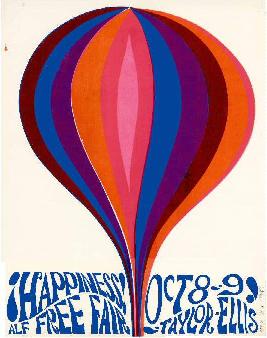
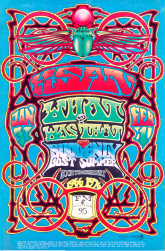
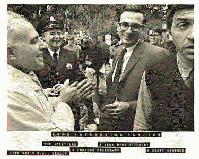
Bust of Mime Troupe Performance, 1965.
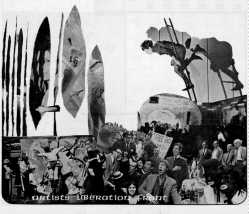
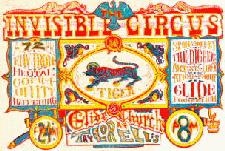
|
